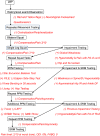The assessment of function. Part II: clinical perspective of a javelin thrower with low back and groin pain
- PMID: 23633887
- PMCID: PMC3360488
- DOI: 10.1179/2042618611Y.0000000018
The assessment of function. Part II: clinical perspective of a javelin thrower with low back and groin pain
Abstract
Assessment of an individual's functional ability can be complex. This assessment should also be individualized and adaptable to changes in functional status. In the first article of this series, we operationally defined function, discussed the construct of function, examined the evidence as it relates to assessment methods of various aspects of function, and explored the multi-dimensional nature of the concept of function. In this case report, we aim to demonstrate the utilization of a multi-dimensional assessment method (functional performance testing) as it relates to a high-level athlete presenting with pain in the low back and groin. It is our intent to demonstrate how the clinician should continually adapt their assessment dependent on the current functional abilities of the patients.
Keywords: Functional testing; Physical performance tests; Physical therapy.
Figures


Similar articles
-
The assessment of function: How is it measured? A clinical perspective.J Man Manip Ther. 2011 May;19(2):91-9. doi: 10.1179/106698111X12973307659546. J Man Manip Ther. 2011. PMID: 22547919 Free PMC article.
-
Critical reflections on the currently leading definition of sustainable employability.Scand J Work Environ Health. 2016 Jun 1;42(6):557-560. doi: 10.5271/sjweh.3585. Epub 2016 Aug 22. Scand J Work Environ Health. 2016. PMID: 27548816
-
Physical performance tests are useful for evaluating and monitoring the severity of locomotive syndrome.J Orthop Sci. 2012 Nov;17(6):782-8. doi: 10.1007/s00776-012-0283-z. Epub 2012 Sep 8. J Orthop Sci. 2012. PMID: 22961424
-
Biomechanical factors critical for performance in the men's javelin throw.Sports Med. 1996 Jun;21(6):438-46. doi: 10.2165/00007256-199621060-00005. Sports Med. 1996. PMID: 8784963 Review.
-
MR imaging of groin pain in the athlete.Semin Musculoskelet Radiol. 2006 Sep;10(3):197-207. doi: 10.1055/s-2006-957173. Semin Musculoskelet Radiol. 2006. PMID: 17195128 Review.
Cited by
-
The bunkie test: descriptive data for a novel test of core muscular endurance.Rehabil Res Pract. 2015;2015:780127. doi: 10.1155/2015/780127. Epub 2015 Feb 11. Rehabil Res Pract. 2015. PMID: 25852955 Free PMC article.
-
ACL Return to Sport Guidelines and Criteria.Curr Rev Musculoskelet Med. 2017 Sep;10(3):307-314. doi: 10.1007/s12178-017-9420-9. Curr Rev Musculoskelet Med. 2017. PMID: 28702921 Free PMC article. Review.
References
-
- Fogel GR, Esses SI. Hip spine syndrome: management of coexisting radiculopathy and arthritis of the lower extremity. Spine J. 2003;3:238–41 - PubMed
-
- Abenhaim L, Rossignol M, Gobeille D, Bonvalot Y, Fines P, Scott S. The prognostic consequences in the making of the initial medical diagnosis of work-related back injuries. Spine (Phila Pa 1976). 1995;20:791–5 - PubMed
-
- Brown MD, Gomez-Marin O, Brookfield KF, Li PS. Differential diagnosis of hip disease versus spine disease. Clin Orthop Relat Res. 2004:280–4 - PubMed
-
- Offierski CM, MacNab I. Hip-spine syndrome. Spine (Phila Pa 1976). 1983;8:316–21 - PubMed
-
- Wainner RS, Whitman JM, Cleland JA, Flynn TW. Regional interdependence: a musculoskeletal examination model whose time has come. J Orthop Sports Phys Ther. 2007;37:658–60 - PubMed
Publication types
LinkOut - more resources
Full Text Sources
